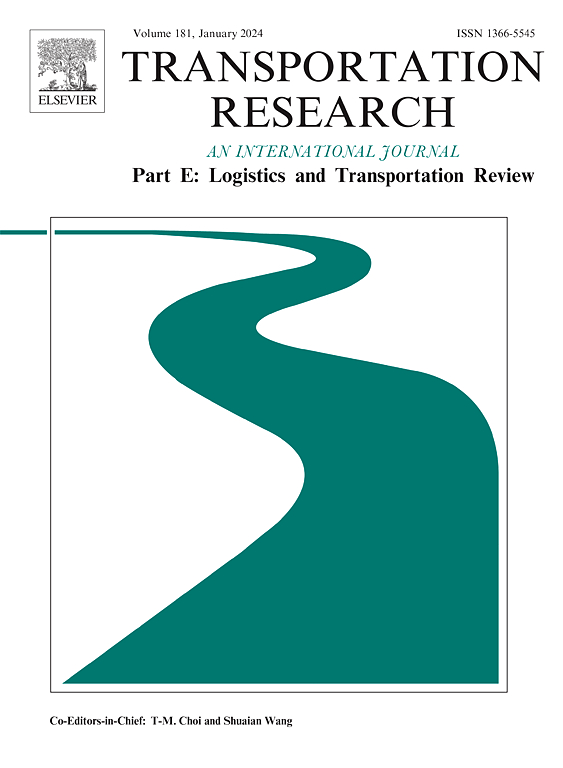Conflict-free routing and flowpath design for automated guided vehicles in container terminals
IF 8.3
1区 工程技术
Q1 ECONOMICS
Transportation Research Part E-Logistics and Transportation Review
Pub Date : 2025-05-22
DOI:10.1016/j.tre.2025.104181
引用次数: 0
Abstract
As the scale of container shipping continuously increases driven by mega vessels and rising transportation demands, Automated Container Terminals (ACTs) have emerged as a promising solution to enhance operational efficiency, leveraging technologies such as automated guided vehicles (AGVs) for container transporting tasks. The AGV traffic within the transportation area, serving as a critical link between quayside and yard side operations, faces challenges due to complex conflicting relations among AGV movements. This study proposes a novel framework for routing and flowpath design (RFD) problem of AGVs in ACTs.Through investigating conflicting mechanisms of AGV movements, the study first proposes conflict-free principles for elementary grid networks, aiming to achieve conflict-free operations and enhance traffic efficiency. Theoretical analysis validates the maximum space–time resource utilization of the RFD under certain conditions. Furthermore, customized design methods are developed to adapt to real-world ACT scenarios, and an integrated optimization model is established to optimize RFD schemes. Numerical experiments are conducted to evaluate the proposed methods, highlighting their effectiveness in enhancing operational efficiency and mitigating traffic congestion in ACTs. This study provides a streamlined yet effective approach to AGV traffic organization within container terminals. By proactively resolving AGV travel conflicts, it addresses the computational challenges in real-time implementation and serves as a cornerstone for effective online operation of AGVs.
集装箱码头自动导引车无冲突路径与流道设计
随着大型船舶和运输需求的不断增长,集装箱运输规模不断扩大,利用自动导引车(agv)等技术来完成集装箱运输任务,自动化集装箱码头(ACTs)已成为提高运营效率的一种有前景的解决方案。运输区域内的AGV交通作为连接码头和堆场作业的关键环节,由于AGV运动之间复杂的冲突关系而面临挑战。本研究提出了一种针对ACTs中agv路由和流道设计(RFD)问题的新框架。通过对AGV运动冲突机制的研究,首先提出了基本网格网络的无冲突原则,旨在实现无冲突运行,提高交通效率。理论分析验证了RFD在一定条件下的最大时空资源利用率。在此基础上,提出了适应现实ACT场景的定制化设计方法,并建立了RFD方案优化的集成优化模型。通过数值实验对所提出的方法进行了评价,突出了它们在提高运营效率和缓解交通拥堵方面的有效性。本研究为集装箱码头内的AGV交通组织提供了一种简化而有效的方法。通过主动解决AGV行驶冲突,解决了实时实现中的计算挑战,是AGV有效在线运行的基石。
本文章由计算机程序翻译,如有差异,请以英文原文为准。
求助全文
约1分钟内获得全文
求助全文
来源期刊
CiteScore
16.20
自引率
16.00%
发文量
285
审稿时长
62 days
期刊介绍:
Transportation Research Part E: Logistics and Transportation Review is a reputable journal that publishes high-quality articles covering a wide range of topics in the field of logistics and transportation research. The journal welcomes submissions on various subjects, including transport economics, transport infrastructure and investment appraisal, evaluation of public policies related to transportation, empirical and analytical studies of logistics management practices and performance, logistics and operations models, and logistics and supply chain management.
Part E aims to provide informative and well-researched articles that contribute to the understanding and advancement of the field. The content of the journal is complementary to other prestigious journals in transportation research, such as Transportation Research Part A: Policy and Practice, Part B: Methodological, Part C: Emerging Technologies, Part D: Transport and Environment, and Part F: Traffic Psychology and Behaviour. Together, these journals form a comprehensive and cohesive reference for current research in transportation science.

 求助内容:
求助内容: 应助结果提醒方式:
应助结果提醒方式:


